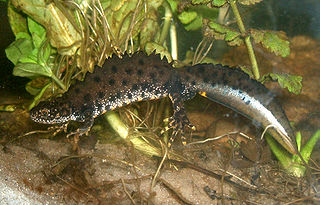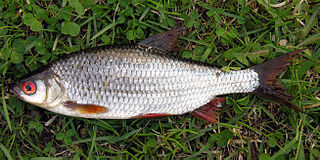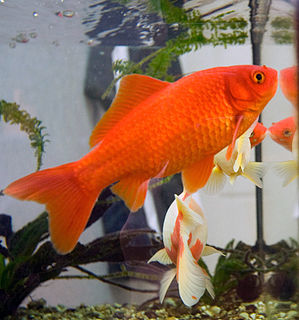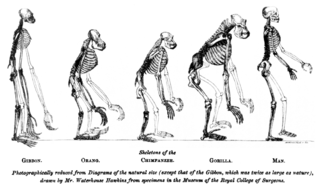
Koi or more specifically nishikigoi, are colored varieties of Amur carp that are kept for decorative purposes in outdoor koi ponds or water gardens.

Emydidae is a family of testudines (turtles) which includes close to 50 species in 10 genera. Members of this family are commonly called terrapins, pond turtles, or marsh turtles. Several species of Asian box turtle were formerly classified in the family; however, revised taxonomy has separated them to a different family. As currently defined, Emydidae is entirely a Western Hemisphere family, with the exception of two species of pond turtle.

Trematoda is a class within the phylum Platyhelminthes. It includes two groups of parasitic flatworms, known as flukes.
A Ramsar site is a wetland site designated to be of international importance under the Ramsar Convention.

The northern crested newt, also known as the great crested newt or warty newt is a newt in the family Salamandridae, found across Europe and parts of Asia.

The Ictaluridae, sometimes called ictalurids, are a family of catfish native to North America, where they are important food fish and sometimes as a sport fish. The family includes about 51 species, some commonly known as bullheads, madtoms, channel catfish, and blue catfish.

The walking catfish is a species of freshwater airbreathing catfish native to Southeast Asia. It is named for its ability to "walk" and wiggle across dry land, to find food or suitable environments. While it does not truly walk as most bipeds or quadrupeds do, it has the ability to use its pectoral fins to keep it upright as it makes a wiggling motion with snakelike movements. This fish normally lives in slow-moving and often stagnant waters in ponds, swamps, streams and rivers, flooded rice paddies or temporary pools which may dry up. When this happens, its "walking" skill allows the fish to move to other sources of water. Considerable taxonomic confusion surrounds this species and it has frequently been confused with other close relatives.

The roach, also known as the common roach, is a fresh and brackish water fish of the Cyprinidae family, native to most of Europe and western Asia. Fishes called roach can be any species of the genera Rutilus and Hesperoleucus, depending on locality. The plural of the term is also roach.

Don Edwards San Francisco Bay National Wildlife Refuge (DESFBNWR) is a United States National Wildlife Refuge located in the southern part of San Francisco Bay, California. The Refuge headquarters and visitor center is located in the Baylands district of Fremont, next to Coyote Hills Regional Park, in Alameda County. The visitor center is on Marshlands Rd, off Thornton Ave.

Pupfish are a group of small killifish belonging to ten genera of the family Cyprinodontidae of ray-finned fish. Pupfish are especially noted for being found in extreme and isolated situations. They are primarily found in North America, South America, and the Caribbean region, but Aphanius species are from southwestern Asia, northern Africa, and southern Europe. As of August 2006, 120 nominal species and 9 subspecies were known.
A lake ecosystem includes biotic (living) plants, animals and micro-organisms, as well as abiotic (nonliving) physical and chemical interactions.

Grafton Pond is a 319-acre (1.3 km2) water body located in Grafton County in western New Hampshire, United States, in the town of Grafton. The pond is part of the Mascoma River watershed, flowing to the Connecticut River. Outflow from the pond travels through Bicknell Brook to Crystal Lake in Enfield, then north to the Mascoma River in West Canaan.
A guild is any group of species that exploit the same resources, or that exploit different resources in related ways. It is not necessary that the species within a guild occupy the same, or even similar, ecological niches. An ecological niche is defined as the role an organism plays in its community, i.e. decomposer, primary producer, etc. Guilds are defined according to the locations, attributes, or activities of their component species. For example, the mode of acquiring nutrients, the mobility, and the habitat zones that the species occupy or exploit can be used to define a guild. The number of guilds occupying an ecosystem is termed its disparity. Members of a guild within a given ecosystem could be competing for resources, such as space or light, while cooperating in resisting wind stresses, attracting pollinators, or detecting predators, such as happens among savannah-dwelling antelope and zebra.

The buffy fish owl, also known as the Malay fish owl, is a species of owl in the family Strigidae.

There are two major sources of fish in Uganda; one is from aquaculture, the other from fishing in rivers and lakes. The latter has made up the largest and most significant share of all fishing. Open water covers 15.3 percent of Uganda's surface and comprises five major lakes (Lake Victoria, Lake Albert, Lake Kyoga, Lake Edward and Lake George which are the main sources of fish in the country. Lake Victoria continues to be the most important water body in Uganda both in size and contribution to the total fish catch, followed by Lake Albert and Lake Kyoga.

The goldfish is a freshwater fish in the family Cyprinidae of order Cypriniformes. It is one of the most commonly kept aquarium fish.

A pond is a body of standing water, either natural or artificial, that is usually smaller than a lake. They may arise naturally in floodplains as part of a river system, or they may be somewhat isolated depressions. They may contain shallow water with marsh and aquatic plants and animals. The type of life in a pond is generally determined by a combination of factors including water level regime and nutrient levels, but other factors may also be important, including the presence or absence of shading by trees, presence or absence of streams, effects of grazing animals, and salinity.
Cyprinid herpesvirus 3 is a species of virus causing a viral disease that is very contagious to the common carp Cyprinus carpio. It is most commonly found in ornamental koi, which are often used in outdoor ponds or as feeder stock. The first case of KHV was reported in 1998, but not confirmed until later in 1999.

Massasoit National Wildlife Refuge was established in 1983 to conserve the federally endangered Plymouth Red-bellied Turtle, as well as other wildlife and plant species. The Refuge encompasses 195 acres (0.79 km2) in Plymouth, Massachusetts. It is made up of two parcels; the Crooked Pond parcel abuts the Myles Standish State Forest, the second largest State forest in Massachusetts, and the smaller parcel is located on the shoreline of Island Pond. Massasoit National Wildlife Refuge is located within a 3,269-acre (13.23 km2) area designated as critical habitat for the Plymouth Red-bellied Turtle.

The danionins are a group of small minnow-type fish belonging to the family Cyprinidae. Members of this group are mostly in the genera Danio, Devario and Rasbora. They are primarily native to the fresh waters of South and Southeast Asia, with fewer species in Africa. Many species are brightly coloured and are available as aquarium fish worldwide. Danio species tend to have horizontal stripes, rows of spots, or vertical bars, and often have long barbels. Devario species tend to have vertical or horizontal bars, and short rudimentary barbels, if barbels are present at all. All danionins are egg scatterers and breed in the rainy season in the wild. They are carnivores living on insects and small crustaceans.

















